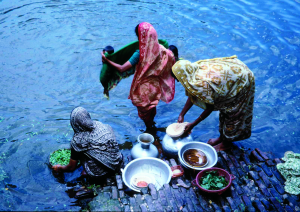Eileen Mariano

In 1986, 3.5 million people in 21 different countries were infected with dracunculiasis. Also known as “Guinea worm disease,”this parasitic infection spreads when people drink water contaminated with Dracunculusmedenisis larvae. The roundworm larvae enter the human body, where they mate and mature in the abdomen. After a yearlong incubation period, the mature, meter-long female worm burrows out of the human’s skin, creating a lesion upon exit. The worm leaves the body very slowly, causing lasting pain for the infected human [1].
Because the lesion caused by the adult worm creates a burning sensation, humans seek relief by submerging the affected area in cool, fresh water. When the adult worm comes in to contact with that water, it releases larvae, infecting the water source. If another human consumes that contaminated water, that person will consequently contract the disease [1].
Though the disease is not fatal, it can be incredibly debilitating. Pain can prevent children from attending school and may keep adults from working or caring for their families. Because the lesion exists for weeks, secondary infections are very common, and prolonged stress to the affected area can cause permanent disability [2].
Even now, there is no vaccine or any type of medication to prevent guinea worm. Treatment consists of removing the emerging adult worm by slowly winding it around a stick, a painful process that takes many weeks [1]. If the worm is pulled too quickly from the skin, it will snap, causing infection and festering [3].
Despite the fact that Guinea worm has no vaccine and no curative medicine, the US Centers for Disease Control and Prevention initiated a global campaign in 1980 to eradicate the disease worldwide [4].Due to successful efforts, in 2012, there were only 542 cases of Guinea worm. By 2013, that number fell to 148 [5].The disease is on track to be eradicated within the decade. Such an accomplishment would be the second disease to be eradicated in human history, preceded only by smallpox. Moreover, it will become not only the first parasitic disease to be eradicated, but also the first disease to be eradicated without use of a vaccine [1].
The question is, given that Guinea worm has no vaccine and no curative medicine, how was the eradication campaign so successful? Success depended on the fact that disease transmission can be interrupted with one simple intervention: education. The World Health Organization, United Nations Children’s Fund, Center for Disease Control and Prevention, and The Carter Center are among several organizations that partner with the ministries of health in countries affected by Guinea worm [1]. The organizations train community health workers to educate members of communities at risk. These health workers are told to stress the importance of two simple behavioral changes. The first: filtering drinking water with a pipe filter or with a cloth [2]. Doing so frees drinking water of worm larvae. The second:teaching people not to submerge a burning lesion in water sources. Doing so prevents the roundworm from contaminating new water sources [1].
Those two behavioral changes have greatly reduced the transmission of Guinea worm[1]. Since 1986, the number of cases has fallen by 99.99%. In an effort to eliminate the few remaining cases, organizations continue to support surveillance and case-finding in both endemic villages and communities at risk of reintroduction. The trained community health workers drive this effort, reporting cases to the overseeing international organizations. Additionally, when a person with Guinea worm is identified, the community health workers treat the person’s symptoms. Then, they remind the patient of the importance of remaining away from water sources, and remind the village of the importance of filtering water [6].
Though the Guinea worm eradication campaign has been almost entirely successful, the final effort to achieve eradication may prove to be the most challenging. Whether remaining cases are found in rural areas or in urban ones, cooperation with the political leaders in endemic countries is essential to eradication. South Sudan, Chad, Ethiopia, and Mali are the four remaining endemic countries, with South Sudan housing 76% of the current cases [1]. Unfortunately, lack of political stability in these four regions makes it difficult for international organizations to cooperate with local governments to achieve elimination.
However, many are hopeful that Guinea worm eradication will be achieved in the near future. In January of 2015, the American Museum of National History will open its exhibit, “Countdown to Zero,” to keep the public continually updated on the number of existing Guinea worm cases until it is eradicated [3].Even more optimistic is 90-year-old Former President Jimmy Carter, who stated, “I want to see Guinea worm eradicated during my lifetime and I’m sure we’ll be successful”[7].
[1] Guinea Worm Eradication Program. The Carter Center. Website.http://www.cartercenter.org/health/guinea_worm/index.html. Published 2014. Accessed November 2, 2014.
[2] Carroll A. Lessons From the Low-Tech Defeat of the Guinea Worm.The New York Times. August 11, 2014.http://www.nytimes.com/2014/08/12/upshot/lessons-from-the-low-tech-defeat-of-the-guinea-worm-.html?module=Search&mabReward=relbias%3Aw%2C%7B%221%22%3A%22RI%3A6%22%7D&_r=0&abt=0002&abg=1. Accessed November 2, 2014.
[3] McNeil Jr. D. Inching Towards Elimination.The New York Times. October 23, 2014.http://www.nytimes.com/2014/10/26/arts/artsspecial/jimmy-carters-fight-against-the-guinea-worm.html. Accessed November 2, 2014.
[4] Parasites- Dracunculiasis (also known as Guinea Worm Disease): Eradication Program. Centers for Disease Control and Prevention. Website.http://www.cdc.gov/parasites/guineaworm/gwep.html. Published April 14, 2014. Accessed November 2, 2014.
[5] Parasites- Dracunculiasis (also known as Guinea Worm Disease): Latest on Guinea Worm Eradication. Centers for Disease Control and Prevention. Website. http://www.cdc.gov/parasites/guineaworm/. Published April 14, 2014. Accessed November 2, 2014.
[6] Guinea Worm Eradication Program. The Carter Center. Website. http://www.cartercenter.org/resources/pdfs/factsheets/guinea-worm-facts.pdf. Accessed November 2, 2014.
[7]Hamdan B. Jimmy Carter Announces Guinea Worm Disease On the Brink of Eradication.Huffington Post. January 16, 2014.http://www.huffingtonpost.com/2014/01/16/jimmy-carter-guinea-worm_n_4609506.html. Accessed November 2, 2014.
